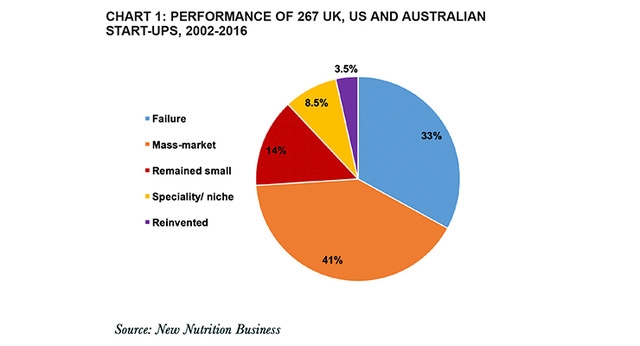Market Updates
Start-Up Brands See Moderately More Success than Established Food Companies
Snack brands have seen an impressive rate of success, according to New Nutrition Business analysis.

By: Sean Moloughney

Investors and consultants alike are full of excitement about the success potential of start-ups. Phrases like “there’s never been a better time to launch a start-up” pop up frequently.
“But the reality is that although start-ups are doing better than established companies, they are only doing a little bit better,” said food industry analyst Julian Mellentin, director of New Nutrition Business. “The success rate among start-up brands is only slightly higher than that of brands from established businesses.”
To address the absence of data on rates of success or failure for start-ups, New Nutrition Business analyzed its database of start-up brands going back to 2002 to shed light on their performance.
The sample comprises 267 U.S., U.K., and Australian food and beverage start-ups that launched products in the years 2002-2016. The sample focuses on snacking, beverages, and dairy (all strongly over-represented among start-ups) as well as kids’ products.
The recent analysis found an overall start-up success rate of 67% (almost the same result as 2016); and an overall failure rate of 33%.
“But if you define ‘real’ success as distribution in mass-market retailers, as opposed to being in niche or regional distribution—which is what most shareholders want—then the success rate falls to 41%,” noted Mellentin.
For comparison, New Nutrition Business also analyzed a sample of 288 brands from established companies—not start-ups—that were launched in 2013 and listed that year in Mintel’s GNPD new product database. They came from the same countries and categories as the start-up sample.
Their overall success rate (whether a brand was in mass distribution or niche) was 54%. “That’s less impressive than the start-ups, but not so far behind,” Mellentin said.
Snacking: A Clear Winner
Mellentin said that if you want to maximize your chances of success and reduce your risk of failure, make your product a snack. “If you had launched a start-up food or beverage business during the years 2002-2016, you would have been most likely to succeed if your launch was a snack or a mini-meal.”
The success rate for snacking start-ups is an impressive 72.5%, compared to 53% for established companies.
That makes sense, Mellentin said. “Snacking makes good sense as a place for a start-up—the products are usually shelf-stable and have a long shelf-life, eliminating the supply chain and wastage problems that kills many start-ups in chilled products.”


